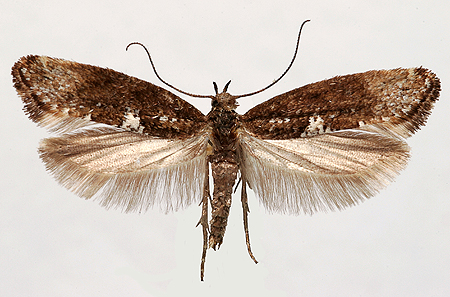Pests
Acrolepiopsis assectella (Zeller) - Leek Moth
Systematic position.
Class Insecta, order Lepidoptera, superfamily Yponomeutoidea, family Acrolepiidae, genus Acrolepiopsis. A subspecies A. assectella caucasica Zagulajev is known from the Caucasus and Crimea.Synonyms.
Acrolepia assectella Z., Argiope assectella Z., Acrolepiopsis vigiliella Duponchel, A. betulella auct.Biological group.
Pest of liliaceous vegetables.Morphology and biology.
Forewings are brown with white transverse stripes and speckles, with light triangular spot at middle of hind margin of the wing (wingspan 12-15 mm). Hindwings gray. Egg oval, matt, 0.4-0.5 mm in length, 0.2 mm in width. Caterpillar of last instar 10-11 mm in length, yellowish-green, with brown warts bearing hairs; head is brown. Pupa is dark brown. Moths, less often pupae, winter on ground near the host plant. Eggs are laid one-by-one on the lower side of a sheet mainly, on bulb neck, into flower shoot and in inflorescence. One female lays about 100 eggs. Embrional development lasts 5-10 days. Hatched caterpillars mine leaves in spring, and shoots and inflorescences in July and August. Caterpillars develop about 2 weeks, molting 4 times. Pupation occurs on or inside leaves. Cocoon is fusiform, thin; the pupa is visible through its walls. The pupa develops 9-15 days.Distribution.
The Leek Moth is known from Europe and Mongolia. In the former USSR, it is distributed in all European parts to Karelia in the north, in the Caucasus, Transcaucasia, Western and Eastern Siberia, the Far East; in Ukraine everywhere.Ecology.
The species has 1-2 generations in Cis-Baikalia; 2-3 in Middle strip, in the Far East and Ukraine; 3-5 generations in the South, in the Caucasus and Transcaucasia. Development of one generation lasts 25-40 days in summer. Moths fly from the end of April to the beginning of October; in Baltic region they fly in middle of June and July until August. Moths are active at twilight and at night, and in the afternoon during cloudy weather. The generations overlap because of prolonged development of stages in nature; and caterpillars, pupae and imagoes meet simultaneously. Abundant rains wash many eggs off plants, and the eggs perish.Economic significance.
The pest injures vegetative and sexual parts of large onion and leek onion, also garlic and wild-growing onion Allium atroviolaceum. It is not often found on other species of the family Liliaceae. The pest causes reduction of bulb size and great loss of seeds in the damaged plants. After the first molt, the caterpillar gnaws out tissue on inner side of tubular leaf, leaving the outer cuticle, thus forming oblong "windows" which gradually increase in size. The damaged leaves and shoots wither, become deformed, and perish. The caterpillars can penetrate into unblown inflorescences, destroying buds. During flowering they eat pedicles, especially harmful to seed onions. The Leek Moth is especially dangerous for weakened and retarded plants. Cold, rainy weather detains the species reproduction. Control measures are as follows: Agronomical ones include crop rotation with repeated sowing of the culture in the same place in at least 3-6 years, destruction of afterharvest residues, deep autumn plowing after onion harvest, placing crops in blowing-through sites. Biological measures (in small holdings) are spraying by tinctures of insecticide plants, such as garlic or cayenne. Chemical ones include insecticide treatments of seed plots after appearance of caterpillars.Reference citations:
Gershenzon Z.S. 1974. Family Arolepiidae. In: Vasil.ev, V.P., ed. Pests of agricultural crops and forest plantations. V.2. Arthropods. Kiev: Urozhai, p. 233-234 (in Russian).Isaev S.I. & Sakhnov A.I. 1932. Materials in biology of some pests of onions. Iss. 1. Vladimir: Uchkombov, 32 p. (in Russian).
Slavgorodskaya-Kurpieva L.E., Slavgorodskii V.E. & Popov V.G. 2001. Protection of agricultural crops against pests and diseases. (The handbook for farmers, gardeners, truck farmers). Simferopol. Biznes-Inform, 344 p. (in Russian).
Zagulyaev A.K. 1994. Family Arolepiidae. In: Kuznetsov V.I., ed. Insects and mites . pests of agricultural plants. V. 3(1). Lepidoptera. St.Petersburg: Nauka, p. 265-269 (in Russian).
Zhemchuzhina A.A. & Stenina N.P. 2001. Protection of garden and kitchen garden against pests and diseases (practical guidance). St.Petersburg: MiM-Del.ta, 608 p. (in Russian).


